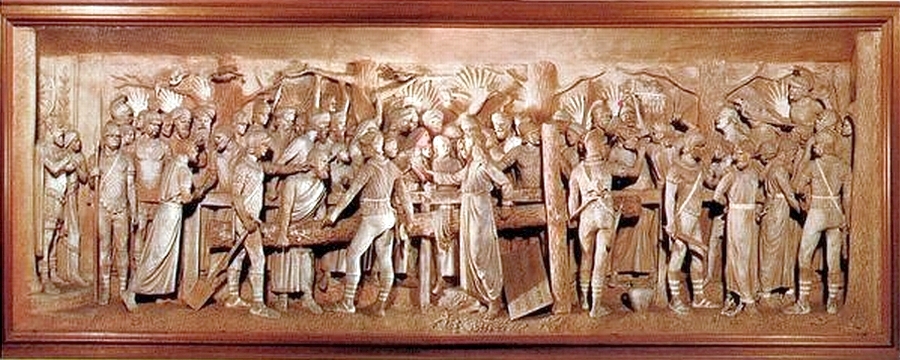
The Way of the Cross, or Going to Calvary, or Our Lord on His Way to the Crucifixion. Terracotta frieze by George Tinworth. Exhibited 1880. Presented to Truro Cathedral in 1902 by F. Walters Bond in gratitude for his sons' safe return from the Boer War (see "Relief: The Entry into Jerusalem"). North Quire Aisle, Truro Cathedral, Cornwall. This was the sort of work for which Tinworth is best known: he "made his name ... with highly modelled terracotta panels showing Biblical scenes," writes Hans van Lemmen (20).
The left side of the relief (detail) shows two centurions forcing Simon the Cyrenian to help carry the cross: "And they compel one Simon a Cyrenian, who passed by, coming out of the country, father of Alexander and Rufus, to bear his cross" (Mark 15, 21).
The right half of the relief (detail): On the left, a centurion tries to quell a disturbance in the crowd accompanying the cross, while one of the the two thieves, who are chained at the ankles and waist, looks back, perhaps hearing Jesus as he addresses the daughters of Jerusalem in the middle (not seen above because of the pillar). "And there were also two other, malefactors, led with him to be put to death" (Luke 23, 32).

Picture of the entire panel, unobscured by the column that stands in front of it in the cathedral, from an old postcard. For all the "busy-ness" of the scene, Tinworth's focus is on Jesus as the central figure, with the daughters of Jerusalem attending to his every word: "Jesus turning to them said, weep not for me, but weep for yourselves, and for your children..." (Luke 23, 28).
Despite its unfortunate siting, Tinworth's panel here is much prized. Indeed, Colin Reid calls it "the most admired piece of sculpture in the Cathedral ... interesting both for the composition and the level of detail." He points out particularly that even the fingers and toenails are shown "with delicate precision" (18). Benedict Read is, in general, less impressed by Tinworth: "it is hard not to feel that his work partakes more of a naive charm that was effective only for the moment, and indeed verges on the tricky 'effectism' of a Marochetti in clogs (as Ruskin's backing might lead one to expect), rather than in being a significant part of a cultural mainstream" (313). Leaving aside the comments on Marchetti and Ruskin (with which one might also disagree), one might ask how important it is for an artist of any kind to be "be a significant part of a cultural mainstream." It is for their individuality and quirkiness that many artists are valued. Perhaps, for some reason deep in the British psyche, this is especially so in this country. Compare Tinworth's work here with the similarly naive but much less "peopled" panels on the façades of the Corn Exchange in Cambridge.
Related Material
The photographs by Robin Banerjee and the author; the one near the end of the document has been reproduced by kind permission of the Cathedral. Formatting by the author. You may use Banerjee's three images without prior permission for any scholarly or educational purpose as long as you (1) credit the photographer and (2) link your document to this URL in a web document or cite the Victorian Web in a print one. [Click on the images to enlarge them.]
Bibliography
Read, Benedict. Victorian Sculpture. Liverpool: Liverpool University Press, 2007.
Reid, Colin. Cornwall's Cathedral: A Short Guide. Hudson's Heritage Group and Truro Cathedral, 2011.
"Relief: The Entry into Jerusalem" (a companion piece). Victorian & Albert Museum. Web. 10 January 2012.
van Lemmen, Hans. Architectural Ceramics. Princes Risborough: Shire, 2002.
Last modified 10 January 2012